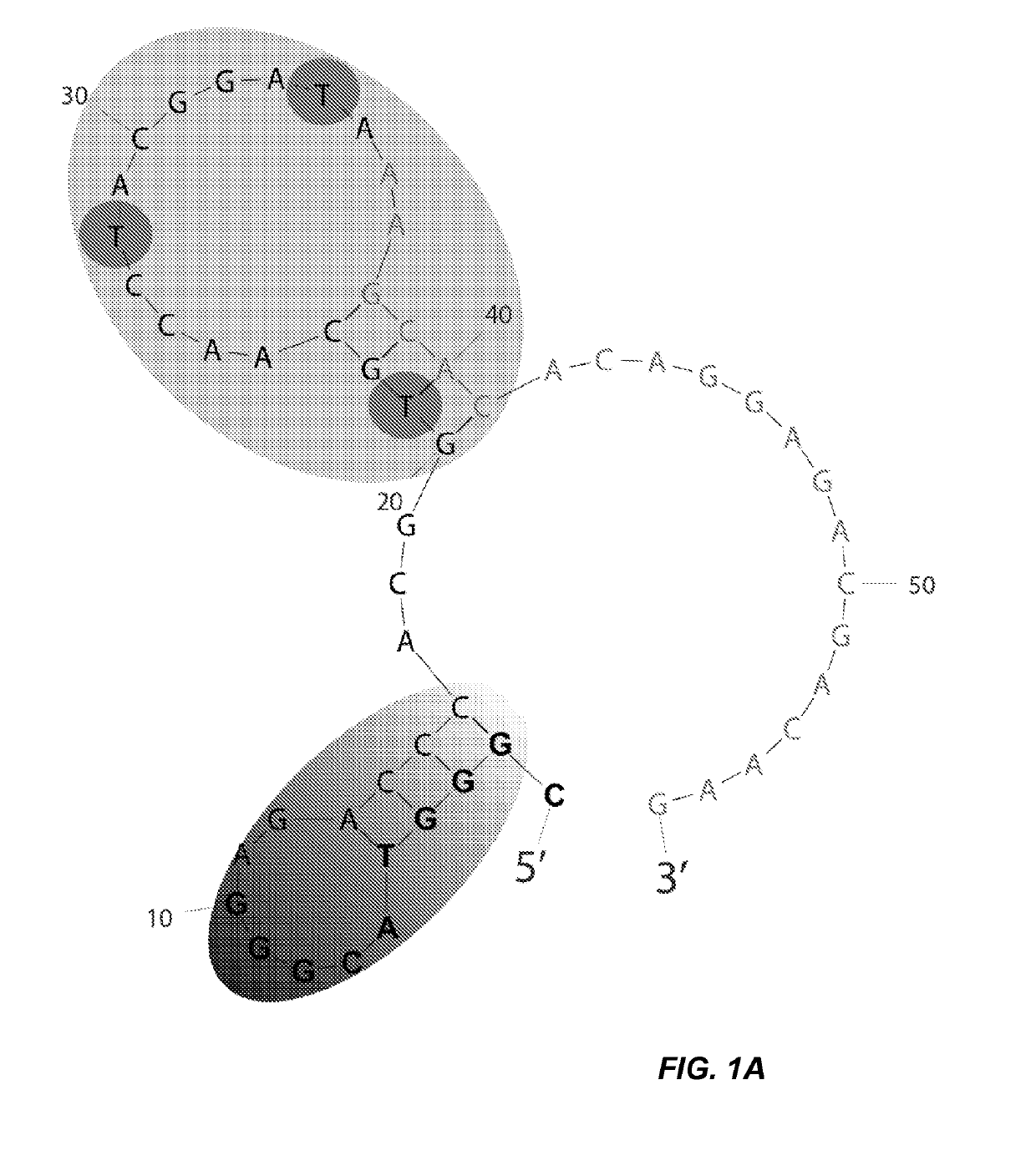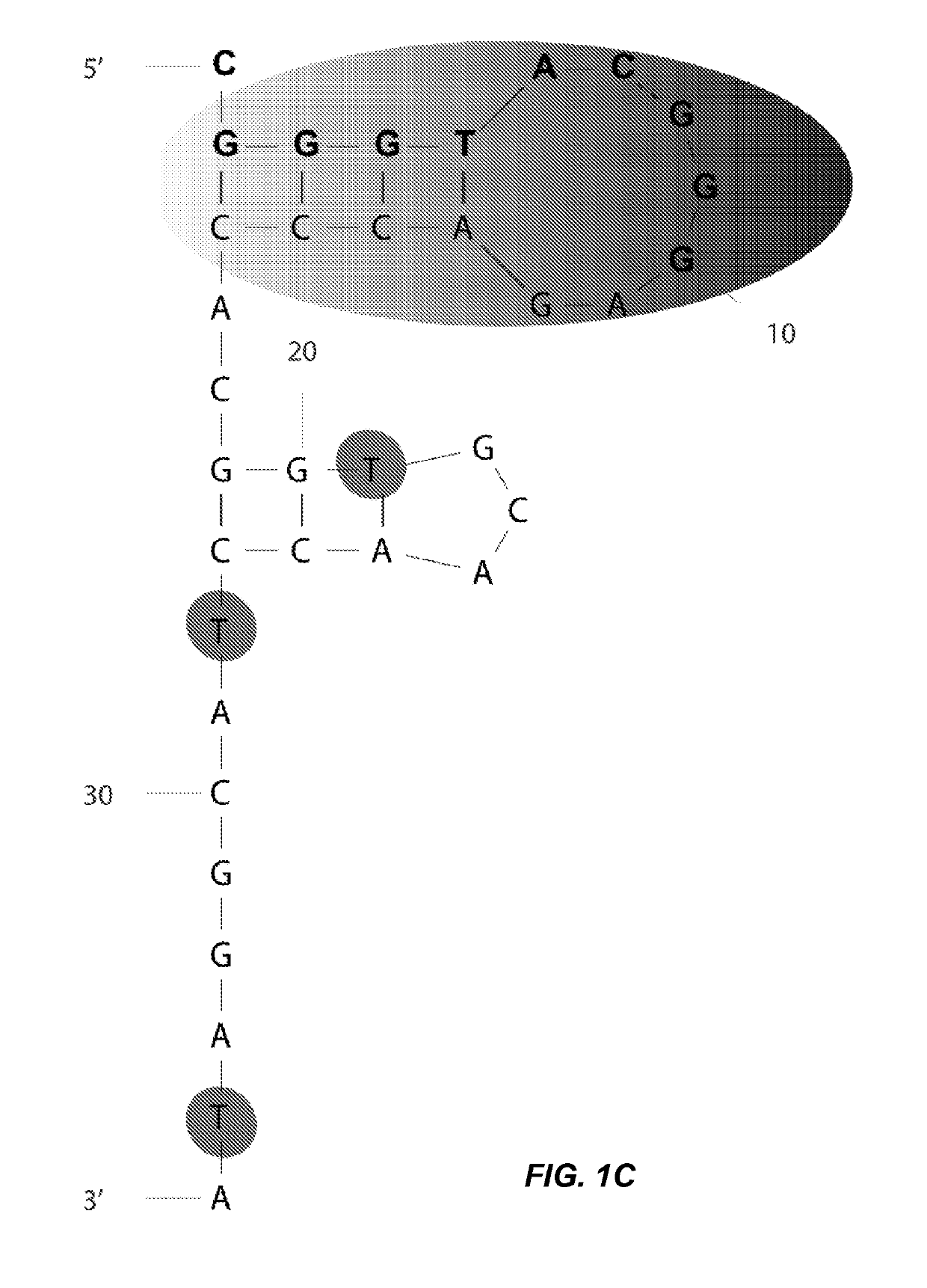Glycosylated oligonucleotides that mimic the hiv-1 epitope of neutralizing monoclonal antibody 2g12
- Summary
- Abstract
- Description
- Claims
- Application Information
AI Technical Summary
Benefits of technology
Problems solved by technology
Method used
Image
Examples
example 1
ion of 2G12 Binding Aptamers
[0105]As reported in PCT Publ. No. WO 2015 / 084846, which is hereby incorporated by reference in its entirety, clones 1 (SEQ ID NO: 7) and 2 (SEQ ID NO: 15) possess the following sequences and 2G12 binding properties.
TABLE 2Sequences, Multivalency and 2G12 Binding of Clones from 37° C.Man9 SelectionCloneGlycansSequenceaKd (nM)bFbmaxb13AGACCCACGGSGCAACCSACGGASA3.1 ± 0.157.9 ± 0.523AGACCCACAGSGCAACCSACGGASA1.7 ± 0.260.9 ± 1.3aS = Man9-click-glycosylated EdU.bKd and Fbmax determined at RT by Nitrocellulose / PVDF filter binding assay, Fbmax expressed as percentage.
[0106]To gain a deeper understanding of the binding domain and structure of clone 1, a binding analysis was performed on a series of truncations. The full length clone 1 (SEQ ID NO: 7) was predicted by mFold analysis to fold into a structure containing two stem loops (FIG. 1A). The green 5′ stem region formed a small hairpin having a 4 bp stem (shaded gradient gray). A second hairpin structure having ...
example 2
of Clone E1 Variant Using 2′-O-Methyl Substituted Nucleotides
[0109]It has been shown that substitutions of purines (adenosine and guanosine) with 2′-methoxy deoxyribose purines can reduce or eliminate endonuclease degradation in serum. Because these modifications of DNA aptamers can affect the folding and binding of the clone, the 2′-methoxy substitutions of the purines should be incorporated systematically and tested for site specific tolerance. Clone E1 will be the subject of a site-specific mutagenesis study. The sequences of the clones to be prepared by solid-phase synthesis are shown in Table 4 below. Once the panel has been synthesized, the binding to 2G12 will be studied as described above. Sites within Clone E1 that are determined to tolerate the 2′-methoxy modification will be combined in a second-generation clone bearing multiple 2′-methoxy modifications. The binding of the advanced generation clone to 2G12 will be verified as previously described. Successful modifications...
example 3
of Clone E1 Variant Using Inverted Oligonucleotides
[0110]A 3′-inverted dT (see FIG. 4) will be appended to the optimized clone obtained from Example 2. The optimized clone will be synthesized on solid support and the cleaved modified DNA will be glycosylated and its binding to 2G12 will be tested as previously described. Having optimized the plasma stability of Clone E1, the 5′ end of the clone will be modified with a thiol to facilitate the attachment of the clone to a maleimide modified carrier protein such as CRM197 (see FIG. 4).
[0111]The E1-CRM conjugate will then be formulated and intramuscularly administered into a naive rabbit population. Plasma from the rabbits will be taken during the course of the experiment and antibody serum titers against E1 and gp120 will be monitored by ELISA.
[0112]Although preferred embodiments have been depicted and described in detail herein, it will be apparent to those skilled in the relevant art that various modifications, additions, substitutio...
PUM
| Property | Measurement | Unit |
|---|---|---|
| Temperature | aaaaa | aaaaa |
| Fraction | aaaaa | aaaaa |
| Mass | aaaaa | aaaaa |
Abstract
Description
Claims
Application Information
 Login to View More
Login to View More - R&D
- Intellectual Property
- Life Sciences
- Materials
- Tech Scout
- Unparalleled Data Quality
- Higher Quality Content
- 60% Fewer Hallucinations
Browse by: Latest US Patents, China's latest patents, Technical Efficacy Thesaurus, Application Domain, Technology Topic, Popular Technical Reports.
© 2025 PatSnap. All rights reserved.Legal|Privacy policy|Modern Slavery Act Transparency Statement|Sitemap|About US| Contact US: help@patsnap.com



